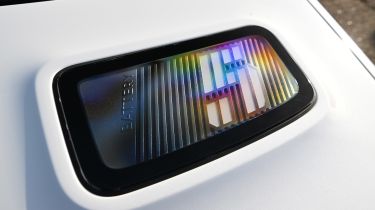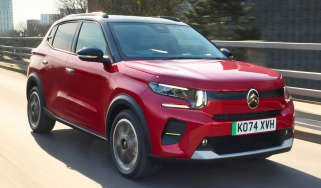Renault 5 review - Range, charging & running costs
“The Renault 5 has a usable range, though buyers wanting to do longer trips should consider something else”
The Renault 5 is available with a choice of 40kWh and 52kWh battery sizes. The larger of the two is capable of up to 249 miles, which isn’t particularly far but fairly standard for an electric supermini. The smaller 40kWh is more limited, with a range of up to 193 miles that will be more suited to those strictly planning shorter trips around town. A Peugeot E-208 can do up to 225 miles on a charge, while the MINI Cooper Electric can travel up to 250 miles from a smaller battery.
The 40kWh battery can be charged at a maximum speed of 80kW, while the 52kWh battery gets faster 100kW charging. That means both cars can be charged up from 15 to 80% in 30 minutes at a public charger.
Home wallbox charging at speeds of up to 11kW is possible, enabling a charge time of around five hours for the 52kWh version. 7kW wallbox charge speeds are more common, though, which will take you overnight to top up.
| Model | Battery size | Range |
| Renault 5 | 40kWh | 193 miles |
| Renault 5 | 52kWh | 249 miles |
How efficient is the Renault 5 in the real world?
In our latest UK drive of the Renault 5 with the 52kWh battery, we achieved efficiency of around 4.1 miles per kilowatt hour, over a mix of roads and at temperatures of about 17 degrees Celsius. At lower speeds we saw that climb to around 5.0mi/kWh, which is much more impressive and actually equates to a range of around 260 miles – that’s more than its on-paper range.
We’ve also tested a left-hand drive version in the UK in very harsh conditions for an EV. It was cold (around six degrees Celsius) and we had the heating on, achieving around 3.6mi/kWh, equating to a real-world range of 187 miles.
What will the Renault 5 cost to insure?
Insurance groups are yet to be announced for the Renault 5 EV. For context, the electric MINI Cooper sits in groups 20 to 26, the Peugeot E-208 in groups 26 to 28, while the electric Fiat 500 spans groups 16 to 18 – with the Renault 5 looking to compete with these models, we’d imagine it will sit in a similar ballpark.
What does the Renault 5 cost to tax?
EVs are no longer exempt from VED (road tax) from April 2025, when it will cost £10 in the first year and then incur the standard rate (currently £195 per year). The good news is that, because the Renault 5 costs less than the £40,000 threshold, it won’t incur the luxury car tax surcharge. As a company car the 5 should be cheap on BiK (Benefit-in-Kind) tax because of its zero-emissions status.
Which Is Best?
Cheapest
- Name90kW Evolution Urban Range 40kWh 5dr Auto
- Gearbox typeAuto
- RRP£22,985
Most Economical
- Name110kW Techno Comfort Range 52kWh 5dr Auto
- Gearbox typeAuto
- RRP£26,985
Fastest
- Name110kW Techno Comfort Range 52kWh 5dr Auto
- Gearbox typeAuto
- RRP£26,985















